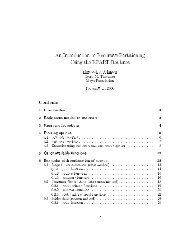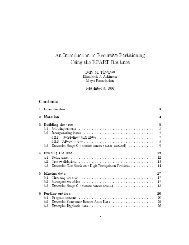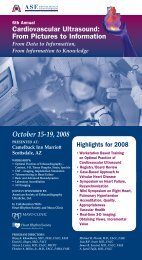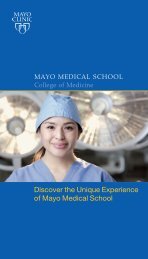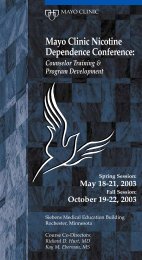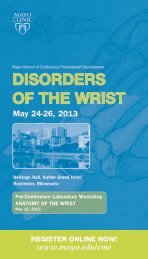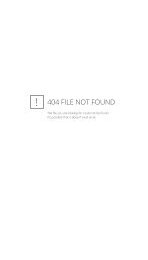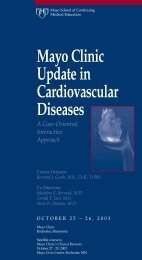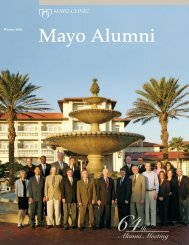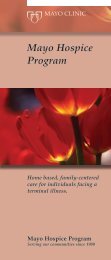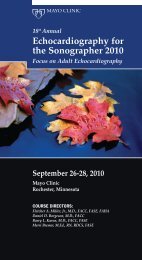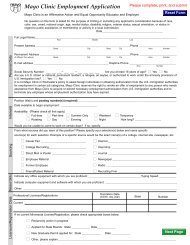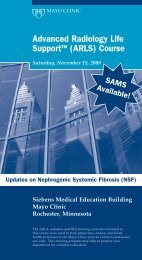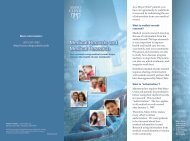Mayo Alumni Magazine 2002 Spring - MC4409-0402 - Mayo Clinic
Mayo Alumni Magazine 2002 Spring - MC4409-0402 - Mayo Clinic
Mayo Alumni Magazine 2002 Spring - MC4409-0402 - Mayo Clinic
Create successful ePaper yourself
Turn your PDF publications into a flip-book with our unique Google optimized e-Paper software.
Testing in the Rochester field<br />
By October, as anthrax outbreaks<br />
began to dominate the news, Roche<br />
Applied Science sent its commercially<br />
prepared reagents back to <strong>Mayo</strong><br />
for testing.<br />
“We didn’t want to announce the<br />
test until sufficient quantities of<br />
testing kits became available — the<br />
work called us out of hiding,” says<br />
Dr. Cockerill. The police brought<br />
Dr. Cockerill’s team several<br />
suspicious packages to examine for<br />
anthrax contamination. When<br />
indentification came quickly, the<br />
research was revealed.<br />
The substances were harmless<br />
powders. Their quick identification<br />
allowed <strong>Mayo</strong> <strong>Clinic</strong> to remain open<br />
and available to patients without<br />
public health risk.<br />
Cooperating with the federal<br />
government<br />
The team has worked with<br />
dignitaries from the United States<br />
Department of Defense as well as<br />
Tommy Thompson, Secretary of<br />
the United States Department of<br />
Health and Human Services.<br />
The cooperative effort has made the<br />
rapid anthrax test formula available<br />
to federal and state agencies<br />
nationwide. Roche Applied Science is<br />
working with the United States Food<br />
and Drug Administration (FDA) to<br />
determine requirements for expedited<br />
regulatory approval.<br />
“On Dec. 21, 2001, the FDA<br />
approved the rapid anthrax test as<br />
an investigational test for testing<br />
human samples,” says Dr. Cockerill.<br />
“Validating the test for human<br />
specimens is difficult because there<br />
are restrictions on the limited number<br />
of human specimens that now exist<br />
and are needed to conduct proper<br />
clinical testing. However, in<br />
cooperation with the federal<br />
government, we’re in the process of<br />
testing human samples.”<br />
The rapid success of the project<br />
was facilitated by collaboration and<br />
cooperation. In addition to the<br />
contributions by <strong>Mayo</strong> scientists and<br />
researchers from other institutions,<br />
<strong>Mayo</strong> Medical Ventures assisted with<br />
the process of developing<br />
relationships with companies in<br />
other countries.<br />
The development of the same-day<br />
diagnostic anthrax test in a period of<br />
weeks, which under normal<br />
circumstances would have taken<br />
months or years, illustrates how<br />
rapidly and effectively <strong>Mayo</strong> can<br />
react in response to a societal need.<br />
— Yvonne Hubmayr<br />
“Making this test<br />
available in a very<br />
short time frame is<br />
our contribution to<br />
the fight against<br />
bioterrorism and<br />
is a direct outcome<br />
of the excellent<br />
cooperation<br />
between Roche<br />
Applied Science<br />
and <strong>Mayo</strong> <strong>Clinic</strong>.”<br />
— Martin Madaus<br />
president and CEO,<br />
Roche Diagnostics Corporation<br />
<strong>Spring</strong> <strong>2002</strong> <strong>Mayo</strong> <strong>Alumni</strong> 7



